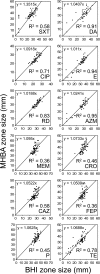Macrolide and clindamycin resistance in Streptococcus milleri group isolates from the airways of cystic fibrosis patients
- PMID: 20404127
- PMCID: PMC2897290
- DOI: 10.1128/AAC.01845-09
Macrolide and clindamycin resistance in Streptococcus milleri group isolates from the airways of cystic fibrosis patients
Abstract
Organisms belonging to the Streptococcus milleri group (SMG) are known for their role in pyogenic infections but have recently been implicated as etiological agents of pulmonary exacerbation in adult patients with cystic fibrosis (CF). The prolonged exposure of CF patients to antibiotics prompted us to investigate the susceptibility profiles of 118 SMG isolates from the airways of CF patients to 12 antibiotics compared to 43 SMG isolates from patients with invasive infections. We found that approximately 60% of all isolates failed to grow using the standard medium for disc diffusion, Mueller-Hinton blood agar (MHBA), so we explored the usefulness of brain heart infusion (BHI) agar for susceptibility testing. Zone-of-inhibition comparisons between BHI and MHBA showed strong correlations for six antibiotics, and interpretations were similar for both medium types. For ceftriaxone and cefepime, both groups of isolates were highly susceptible. Tetracycline resistance levels were comparable between the two groups (22% in CF isolates and 17.4% in invasive isolates). However, more than half of the CF isolates were not susceptible to azithromycin, erythromycin, and clindamycin, compared to 11%, 13%, and 6.5% of invasive isolates, respectively. There were 5-fold and 8-fold increased risks of azithromycin and clindamycin resistance, respectively, for the isolates from the airways of CF patients relative to the invasive isolates. Macrolide resistance was strongly linked to chronic azithromycin therapy in CF patients. This study shows that BHI agar is a suitable alternative for antimicrobial susceptibility testing for the SMG and that SMG isolates from the airways of CF patients are more resistant to macrolides and clindamycin than strains isolated from patients with invasive infections.
Figures




Similar articles
-
Molecular characterization of macrolide resistance determinants [erm(B) and mef(A)] in Streptococcus pneumoniae and viridans group streptococci (VGS) isolated from adult patients with cystic fibrosis (CF).J Antimicrob Chemother. 2009 Sep;64(3):501-6. doi: 10.1093/jac/dkp213. Epub 2009 Jul 7. J Antimicrob Chemother. 2009. PMID: 19584106
-
Macrolide resistance of Staphylococcus aureus and Haemophilus species associated with long-term azithromycin use in cystic fibrosis.J Antimicrob Chemother. 2006 Apr;57(4):741-6. doi: 10.1093/jac/dkl014. Epub 2006 Feb 9. J Antimicrob Chemother. 2006. PMID: 16469851
-
Antibiotic susceptibility and molecular mechanisms of macrolide resistance in streptococci isolated from adult cystic fibrosis patients.J Med Microbiol. 2015 Nov;64(11):1375-1386. doi: 10.1099/jmm.0.000172. Epub 2015 Sep 25. J Med Microbiol. 2015. PMID: 26408040
-
The Streptococcus milleri group--an unrecognized cause of disease in cystic fibrosis: a case series and literature review.Pediatr Pulmonol. 2008 May;43(5):490-7. doi: 10.1002/ppul.20809. Pediatr Pulmonol. 2008. PMID: 18383109 Review.
-
The Yin and Yang of Streptococcus Lung Infections in Cystic Fibrosis: a Model for Studying Polymicrobial Interactions.J Bacteriol. 2019 May 8;201(11):e00115-19. doi: 10.1128/JB.00115-19. Print 2019 Jun 1. J Bacteriol. 2019. PMID: 30885933 Free PMC article. Review.
Cited by
-
Draft Genome Sequence of Streptococcus anginosus BVI, a New Vaginal Pathogen Candidate.Genome Announc. 2016 Dec 15;4(6):e01417-16. doi: 10.1128/genomeA.01417-16. Genome Announc. 2016. PMID: 27979955 Free PMC article.
-
Group B streptococcus (GBS) is an important pathogen in human disease- but what about in cystic fibrosis?BMC Infect Dis. 2017 Oct 2;17(1):660. doi: 10.1186/s12879-017-2729-6. BMC Infect Dis. 2017. PMID: 28969684 Free PMC article.
-
Auto-aggregation in Streptococcus intermedius is driven by the Pel polysaccharide.mBio. 2025 Aug 13;16(8):e0119625. doi: 10.1128/mbio.01196-25. Epub 2025 Jul 7. mBio. 2025. PMID: 40621902 Free PMC article.
-
Draft Genome Sequence of Streptococcus anginosus UMB7768, Isolated from a Woman with Recurrent UTI Symptoms.Microbiol Resour Announc. 2020 May 21;9(21):e00418-20. doi: 10.1128/MRA.00418-20. Microbiol Resour Announc. 2020. PMID: 32439677 Free PMC article.
-
Inflammation in children with cystic fibrosis: contribution of bacterial production of long-chain fatty acids.Pediatr Res. 2021 Jul;90(1):99-108. doi: 10.1038/s41390-021-01419-4. Epub 2021 Mar 2. Pediatr Res. 2021. PMID: 33654282 Free PMC article.
References
-
- Ahmed, R. A., T. J. Marrie, and J. Q. Huang. 2006. Thoracic empyema in patients with community-acquired pneumonia. Am. J. Med. 119:877-883. - PubMed
-
- Alcaide, F., J. Liñares, R. Pallares, J. Carratala, M. A. Benitez, F. Gudiol, and R. Martin. 1995. In vitro activities of 22 beta-lactam antibiotics against penicillin-resistant and penicillin-susceptible viridans group streptococci isolated from blood. Antimicrob. Agents Chemother. 39:2243-2247. - PMC - PubMed
-
- Aracil, B., J. L. Gómez-Garcés, and J. I. Alós. 1999. A study of susceptibility of 100 clinical isolates belonging to the Streptococcus milleri group to 16 cephalosporins. J. Antimicrob. Chemother. 43:399-402. - PubMed
-
- Asmah, N., B. Eberspacher, T. Regnath, and M. Arvand. 2009. Prevalence of erythromycin and clindamycin resistance among clinical isolates of the Streptococcus anginosus group in Germany. J. Med. Microbiol. 58:222-227. - PubMed
-
- Ball, J. L., R. M. Malhotra, P. Leong, and A. S. Bacon. 2000. The importance of recognising Streptococcus milleri as a cause of orbital cellulitis. Eye (Lond.) 14(5):814-815. - PubMed
Publication types
MeSH terms
Substances
Grants and funding
LinkOut - more resources
Full Text Sources
Medical
Molecular Biology Databases

